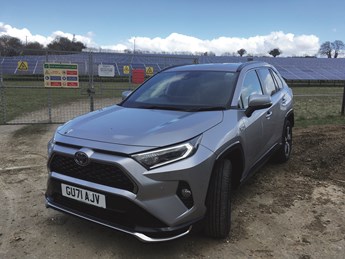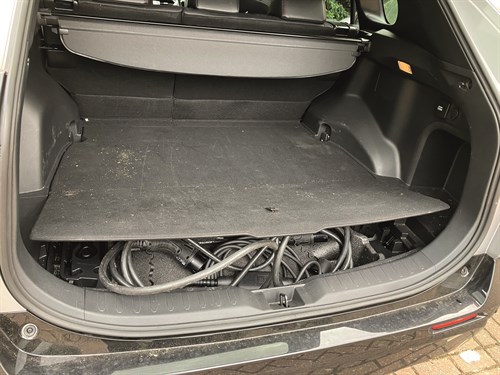We use cookies to ensure that we give you the best experience on our website. If you continue without changing your settings, we will assume that you are happy to receive all cookies on the Business Car website. However, if you would like to, you can change your cookies at any time

The start point for the best source of fleet information |
Final report: Toyota RAV4 long-term test
Date: 13 July 2022 | Author: Pete Tullin

|
|
||||||||||||
Final Report: A life less ordinary
Sadly, our time with the RAV4 plug-in has come to end. I say sadly because without question, Toyota's funky SUV it is one of the most well-rounded vehicles currently on sale.
I've spoken previously of its excellence in almost every area and its ability to transform the most tedious journey into a relaxing and enjoyable experience, thanks in no small part to its exceptional comfort and refinement.
I've also been wowed by its inherent practicality, including lots of passenger space, plenty of storage areas and a boot that is capable of swallowing all manner of goods and chattels.
In truth, I found so little to fault that I've had to rely on every ounce of my Poirot sleuthing skills to unearth any shortcomings. If I'm super-picky, I'd question the parking brake auto-hold function, as it requires a little too much foot pressure to activate for my liking, and on a couple of occasions I found myself creeping perilously close to the car in front before applying an additional stab of the pedal. Given Toyota has made the activation of this labour saving device virtually seamless, - there's not a hint of the whirr and graunch that afflicts so many rivals - it's a bit of a victim of its silky success, as the only way you can register if it is activated, or not, is by checking the illuminated icon on the dash.
One other niggle involves the charging cables. Don't get me wrong, unlike many electrified vehicles, which have no storage provision and allow their cables to roam feral in the boot, Toyota does provide underfloor storage for its two charging cables. What's more, the cables are extremely lengthy, so you'll never have to trudge the walk of shame when you realise you've parked too far away from the charge point. Trouble is, trying to get these extension cables neatly wound up without soiling your hands or clothing and then storing them neatly in their underfloor cubby is akin to wrestling a slippery Anaconda.

My final gripe relates to the powered tailgate, which works flawlessly but insists you loiter around waiting for it to latch before it will permit you to lock the rest of the doors.
Without question, the thing that amazes me most about the RAV is its fuel consumption. Like many folks, I am inclined to take official figures with a healthy grain of salt and although the WLTP lab testing data is more accurate than the previous farcical NEDC tests, when I first set eyes on the RAV's stratospheric 282.5mgp average, I immediately thought someone must be taking the Michael.
Of course, this figure is massively influenced by the RAV's 46-mile EV range so if you don't plug it in you will be more likely to get around 50mpg.
If you never exceed the EV range, however, and plug-in every night then the 282.5mpg becomes a pretty arbitrary number because you could end up using no fuel whatsoever.
Of course, convincing the taxman of your unleaded abstinence is likely to fall on deaf ears but with a BIK implication of just 8%, it's probably wise not to rock the boat, especially if there's any truth in the rumours that in the not too distance future users will need to provide proof of plug-in regimes to maintain low tax implications.
I have never witnessed anything approaching triple figures but I have regularly seen over 90mpg and that's still a hell of an achievement in my book.
That's the thing about the RAV4. Despite looking so similar to so many other vehicles in the super popular mid-sized SUV sector, it has a happy knack of transforming. To put it simply, what on the surface appears to be run-of-the-mill turns into something truly exceptional.
2nd Report: Struggling to be negative
Don't you just love those beaming Instatube influencers?
"Yo, what's up people, have we got another brilliant product review for you today?" I swear, if just one of them, just once, were to say "today we are reviewing a product that's rather mediocre" I'd run outside and start handing out free beer to random passersby.
Of course, my natural distrust of these glowing testimonials does put me in a bit of a pickle when it comes to writing about our long term RAV4 plug-in hybrid. This is because, try as I might - and trust me I've tried - I am struggling to find anything negative to say about Toyota's best-selling model. I've even resorted to a dirty tricks campaign in an effort to throw it a curveball. I've always been somewhat suspicious of plug-in hybrids because if you don't plug them in, and many folks still won't, then you are simply hauling around a load of dead weight in the guise of a whopping great battery and therefore relying almost entirely on the petrol engine to get you from A to B, with the obvious negative effects on fuel economy.
With this in mind, I have purposely not charged the RAV's battery for a month now, thinking a big old bus with a fairly substantial 2.5-litre 4-cylinder engine under the bonnet would probably do well to better 30mpg. Well, the results are in, and believe it or not, ladies and gentlemen, a sustained period of general motoring, including a fair mix of motorway hauls and urban commuting has resulted in average fuel consumption of 51.7mpg. Ok, so that's not in the same stratosphere as the 282.5mpg average that Toyota claims the RAV is capable of, but it is still pretty impressive given it has achieved this figure with zero plug-in assistance. Contrary to this strategy, I will be plugging the RAV in at every opportunity and running the drivetrain in its hybrid combo mode for the next month to see just how close I can get to the official combined average.

Given the lack of matters to moan about, I have to admit to a bout of childish schadenfreude when I thought I had discovered a glitch with the RAV, but this turned out to be groundless.
Along with a reticence to offer a fully electric vehicle - something that will be remedied this year with the bZ series of models - Toyota was one of the last manufacturers to offer Apple Carplay in its European models. So, when my iPhone failed to connect, and I was left bereft of my favourite Waze navigation App, I was all for cursing Toyota's lack of software development. Just to be sure, I checked the connectivity via a couple of spare iPhone leads and even resorted to gently poking a toothpick into the USB to tease out any signal hindering detritus to no avail.
Consequently, I was beginning to feel pretty confident that there must be a rabbit off with the system, but as it turns out the problem was not with the RAV but with the iffy port in my old dog and bone.
Many people may look at the RAV and conclude it's not the prettiest car in the world and others may question some of the rather plain Jane aspects of the interior design and I'd have some sympathy with that view. Overall though, I'll gladly let the looks side of the equation slide because when it comes to just getting the job done, the RAV is as good as it gets.
As well as being impressively comfortable and extremely refined, it is also surprisingly powerful, exceptionally spacious, and insatiably practical.
What's more, if Toyota's reliability reputation is anything to go by, I suspect this is situation that will continue for the foreseeable. I'll keep you posted if anything changes but, in the meantime, don't hold your breath.
1st Report: A spin with the plug-in RAV4
When it was originally launched as an SUV styled alternative to 1980's hot-hatches the Toyota RAV4 quickly developed an avid fan base amongst those who loved its quirky styling, spirited performance and thrill-a-minute handling.
With that sort of goodwill in its sails, it seems all the more unfathomable that Toyota then spent the next few decades progressively dumbing down successive generations of RAV.
Fortunately, a couple of years ago someone finally realised this was an untenable situation but instead of revisiting the hedonistic exuberance of the 1980s for inspiration set about creating a 21st century RAV4.
It may no longer be the type of car that you take for a Sunday morning strop- more than anything, its sheer size will preclude those kind of activities- but that's not to say the latest RAV lacks precision and with a combined power output of 306hp nestling under the bonnet, it'll certainly scuttle along at a fair old rate when you lean on it.
Best of all, the latest RAV rides with an assured serenity that puts many a luxury car in the shade so, those long drawn out trips to that last Friday afternoon meet will be dispatched with minimal stress.
Now if you're one of those folks who shudder at the mere thought of hybrid, CVT powertrains then hold on tight, because Toyota's latest motivator will stand your preconceptions on their heads.
For a start, the gearbox is not a continuously variable transmission in the conventional sense of the words. It's actually an eCVT, which means that instead of employing all manner of chains and hydraulically activated pulleys to vary the pace of the drive and send the engine's revs screaming like a banshee at the faintest hint of accelerator pressure, the RAV uses what Toyota refers to as a power split device.
In a nutshell, this is a single planetary gear set and is employed to merge the various driving and charging regimes of the two electric motors as well as engage the power output from the 2.5-litre four-cylinder petrol engine. The multiplicity of the various driving and charging modes that Toyota conjures up via this process may be enough to make your head swim but all you need to know is the RAV delivers its power seamlessly, forcefully and in an extremely refined manner.
One of the biggest advantages of living with a Plug-in hybrid is its ability to run solely on electric power and in this respect, my early experiences have shown the RAV to be true to its claims; easily covering 40-odd miles on a full charge when driven considerately. In order to ascertain a true understanding of its fuel efficiency, the official figure is a frankly staggering 282.5mpg, I've decided to keep a logbook. Although the trip computer is suggesting I'm averaging a creditable 59mpg using a mixture of electric and petrol power, I'm not entirely sure how this is calculated, as after every journey a brief message comes up on the dash with the mpg achieved since start-up and it is usually well shy of the quoted average. Consequently, I figure the best way to work out the true mileage is the old-fashioned method of recording mileages between fill-ups, noting those with a full battery and those with depleted cells.
On the accommodation front, the latest RAV4 is absolutely massive compared to the original, so instead of you shoehorning the kids into the cheap seats, the whole gang will get to travel in comfort thanks to an almost totally flat floor, heated rear seats and reclining rear seatbacks. The boot is also gargantuan, capable of carrying a quartet of golf bags or enough suitcases to satisfy the thirst of several Downing Street parties.
As with most Toyota's, the interior finish is more bacon butty than eggs Benedict, so it doesn't exactly scream high-end luxury but what it lacks in flash it makes up for with robust appointment and super-solid construction. No doubt that's something I'll rigorously put to the test over the coming months.











